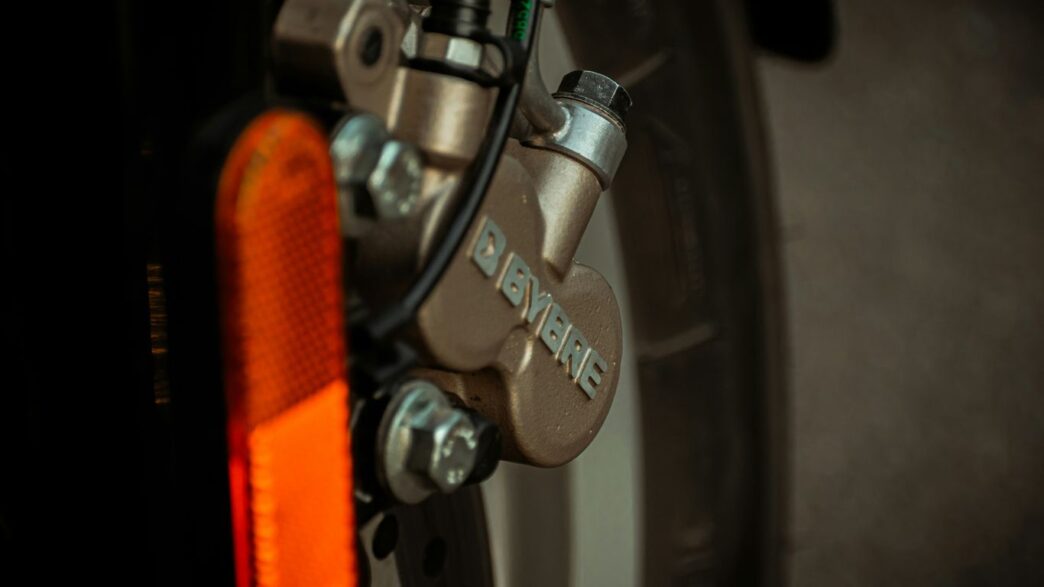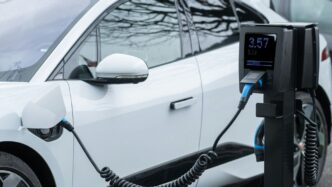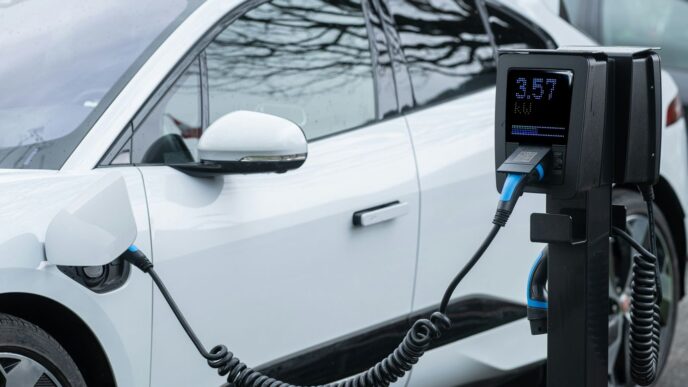Pickup trucks have always been about power and getting the job done. But lately, things are changing. We’re seeing more trucks that can run on electricity, and one type that’s getting a lot of attention is the plug-in hybrid, or PHEV truck. These trucks offer a mix of gas and electric power, giving you options for how you drive and refuel. If you’re curious about what a PHEV truck is and what’s coming down the road, you’ve come to the right place. Let’s take a look at the growing world of the phev truck.
Key Takeaways
- A PHEV truck combines a gas engine with an electric motor and a battery you can charge from an outlet, offering electric-only driving for shorter trips and gas for longer ones.
- While no PHEV trucks are currently for sale in the US, models like the upcoming Ram 1500 Ramcharger and the international Ford Ranger PHEV show where the market is heading.
- The main draw of a PHEV truck is better gas mileage and fewer emissions compared to traditional trucks, plus the instant power you get from electric motors.
- Owning a PHEV truck might mean a higher sticker price upfront, and you’ll need to think about where and how you’ll charge it.
- To get the most out of your PHEV truck, it’s a good idea to charge it regularly and understand how its hybrid system works, especially when it comes to maintenance.
Understanding The PHEV Truck Landscape
So, you’re curious about plug-in hybrid (PHEV) trucks? It’s a pretty interesting space right now, with a lot of buzz but not a ton of actual models you can walk into a dealership and buy in the US, at least not yet. Think of it as the next step in how trucks are evolving, trying to blend the best of both worlds: the power and utility we expect from a pickup, with the fuel savings and lower emissions that electrification promises.
What Defines A Plug-In Hybrid Truck?
A plug-in hybrid truck, or PHEV, is basically a vehicle that has both a gasoline engine and an electric motor, but with a bigger battery than a regular hybrid. The key difference is that you can plug it in to charge that battery from an external source, like your home outlet or a charging station. This allows it to travel a certain distance on pure electricity alone before the gasoline engine kicks in. This ability to run on electricity for a decent range is what really sets PHEVs apart. It means you could potentially do your daily commute or short errands without using any gas at all, which is pretty neat.
The Evolution of Electrified Pickups
Trucks have been around forever, mostly running on good old gasoline or diesel. Then came the regular hybrids, which helped save a bit on fuel by using electric motors to assist the engine. Now, we’re seeing the rise of fully electric trucks, which are cool but come with their own set of considerations, like charging times and range. PHEVs are kind of the middle ground. They offer a bridge for folks who aren’t quite ready to go fully electric but still want better fuel economy and a taste of electric driving. The market for electric trucks is expected to grow a lot in the coming years, and PHEVs are a part of that shift [df5c].
Key Differences: PHEV vs. Full Hybrid vs. Mild Hybrid
It can get a little confusing with all the different hybrid types out there, so let’s break it down:
- Mild Hybrid: These have a small electric motor that just gives the gas engine a little boost, mostly during acceleration or when the engine would normally stop and start. You won’t be driving on electricity alone with a mild hybrid.
- Full Hybrid: These have a more capable electric system that can power the truck for short distances at low speeds. The battery charges itself through braking and the engine. You can’t plug these in.
- Plug-In Hybrid (PHEV): This is the one we’re talking about. It has a larger battery that you can plug in to charge. This gives it a significant electric-only driving range, often around 20-40 miles, before the gasoline engine takes over. This is the type of truck that’s starting to appear, like the upcoming Ram 1500 Ramcharger.
Here’s a quick look at how they generally stack up:
| Feature | Mild Hybrid | Full Hybrid | Plug-In Hybrid (PHEV) |
|---|---|---|---|
| Electric-only Range | Minimal | Short | Moderate (20-40+ mi) |
| Charging | No | Self-charging | Plug-in required |
| Fuel Efficiency | Slightly better | Good | Very Good (when charged) |
| Emissions | Slightly lower | Lower | Lowest (when charged) |
Upcoming PHEV Truck Models To Watch
Alright, so you’re curious about what’s next in the world of plug-in hybrid trucks. It’s a pretty exciting time because, honestly, there haven’t been many options for us folks who want that electric boost but still need the flexibility of a gas engine. But things are changing, and a few key players are stepping up.
The Ram 1500 Ramcharger: A Glimpse Into The Future
This one’s a big deal for the US market. The Ram 1500 Ramcharger is shaping up to be one of the first true plug-in hybrid pickup trucks available here. What’s really interesting is how Ram is doing it. It’s not just a regular hybrid; it’s designed to act more like an electric truck with a gasoline engine that acts as a generator to keep things powered up. They’re aiming for a massive total range, combining electric and gas power, which is exactly what many truck buyers have been waiting for.
Here’s a quick look at what we’re hearing:
- Powertrain: Expect a dual-motor setup for all-wheel drive, paired with a substantial 92-kWh battery pack. The gasoline engine’s job is to charge the battery, not directly power the wheels.
- Estimated Range: Ram is talking about a significant electric-only range, potentially around 145 miles, and then an additional 545 miles when the generator kicks in. That’s a lot of miles between fill-ups and charges.
- Performance: Combined horsepower is projected to be around 663 hp, with 619 lb-ft of torque. That should make it pretty capable, even for towing.
- Availability: It’s slated for a 2025 model year release, likely showing up in dealerships in early 2025.
Ford Ranger PHEV: International Appeal
Over in other parts of the world, Ford is getting ready to offer a plug-in hybrid version of the Ranger. While it’s not currently planned for the US market, it’s still worth keeping an eye on as it shows the direction automakers are heading.
Some details that have surfaced:
- Battery & Electric Range: It’s expected to have a 13.8-kWh battery pack, giving it about 33 miles of electric-only driving. Not a huge amount, but enough for short commutes or errands.
- Charging: It’ll come with a 7.2-kW onboard charger, meaning you could potentially recharge it in under two hours using a Level 2 home charger. That’s pretty convenient.
- Combined Power: The system is said to produce around 268 horsepower and 258 lb-ft of torque. Once the battery is depleted, it should still get decent gas mileage.
Jeep Gladiator 4xe: A New Contender Emerges
Jeep has already shown us what they can do with plug-in hybrid technology in their Wrangler 4xe, and it looks like the Gladiator pickup is next in line. This is exciting because it brings that off-road capability that Jeep is known for into the PHEV truck segment.
What we might see:
- Familiar Tech: It’s likely to borrow heavily from the Wrangler 4xe’s setup, which includes a 17.0-kWh battery pack. This should provide a decent chunk of electric-only miles, probably around 21 miles based on the Wrangler.
- Off-Road Ready: The combination of a 2.0-liter turbo engine and electric motors is proven to work well for serious off-roading, so expect the Gladiator 4xe to be just as capable.
- Power Output: The Wrangler 4xe makes a combined 375 horsepower and 400 lb-ft of torque, and it’s reasonable to expect similar figures for the Gladiator.
- Timeline: Jeep has confirmed it’s coming, with an arrival expected sometime in 2025. We’ll need to wait for more official specs, but it’s definitely one to watch.
Benefits Of Choosing A PHEV Truck
So, you’re thinking about a plug-in hybrid pickup? That’s a smart move, honestly. These trucks pack a punch when it comes to what they can do for you, both on the road and for your wallet. They really offer a sweet spot between traditional gas power and full electric.
Enhanced Fuel Efficiency And Reduced Emissions
Let’s talk about saving money at the pump. PHEV trucks combine a gasoline engine with an electric motor and a battery you can actually plug in to charge. This means you can do a lot of your daily driving on electricity alone, which is way cheaper than gas. Even when the battery runs low, the gas engine kicks in, but you’re still getting better mileage than a regular truck. It’s a win-win for your budget and the environment. You’re cutting down on those tailpipe emissions, which is always a good thing. For many drivers, this means a significant reduction in their overall fuel consumption, making it a worthwhile investment for truck buyers looking to save on gas. hybrid trucks offer
Versatile Performance And Instant Torque
Don’t think for a second that going hybrid means sacrificing power. PHEVs actually give you the best of both worlds. That electric motor provides instant torque, meaning when you hit the gas pedal, you get immediate acceleration. This is super handy for merging onto highways or just getting up to speed quickly. Plus, the combination of the electric motor and gas engine means you have power available in different situations. Whether you’re cruising on the highway or tackling some tougher terrain, the hybrid system can adapt. It’s a really flexible setup that feels responsive and capable.
Quieter Operation And Improved Driving Comfort
One of the first things you’ll notice is how quiet these trucks are, especially when running on electric power. It’s a much more relaxed driving experience compared to a noisy gas or diesel engine. City driving becomes a lot more pleasant, and even on longer trips, the reduced engine noise makes for a more comfortable ride. The transition between electric and gas power is usually pretty smooth too, so you’re not getting jolted around. It just makes the whole experience of driving your truck feel a bit more refined.
Considerations For PHEV Truck Ownership
So, you’re thinking about a plug-in hybrid truck. That’s cool. They offer a lot, but like anything new, there are a few things to keep in mind before you sign on the dotted line. It’s not just about the shiny tech; it’s about how it fits into your life.
Higher Initial Purchase Price
Let’s get the big one out of the way first: these trucks usually cost more upfront than their gas-only cousins. You’re paying for that advanced battery and electric motor tech, plus the engineering that makes it all work together. It’s a trade-off, for sure. You’re getting better fuel economy and potentially lower running costs down the road, but that initial sticker shock can be a bit much for some folks. Think of it like buying a really nice tool – it costs more, but it’s supposed to last longer and do a better job.
Understanding Charging Infrastructure
This is a pretty big deal for PHEVs. Unlike regular hybrids that just handle their own charging, a plug-in hybrid needs to be plugged in to get the most benefit. This means you’ll need a place to charge it regularly. If you live in an apartment or don’t have a garage or driveway where you can install a charger, figuring out public charging can be a hassle. The availability of charging stations is still growing, especially outside of major cities. It’s worth checking out what’s near your home and work, and also along routes you frequently travel. You can find out more about charging options for electric and hybrid vehicles.
Potential Impact On Towing And Payload
Trucks are built to work, right? So, towing and payload capacity are usually top priorities. While PHEV trucks are getting pretty good, they might not always match the raw numbers of their all-gas counterparts. The extra weight from the battery and electric components can sometimes mean a slightly lower maximum towing or hauling limit. For example, a gas F-150 might offer more pounds of towing than its hybrid sibling. However, the instant torque from the electric motor can actually make towing feel smoother and more responsive at lower speeds. It’s a different kind of capability, and you’ll want to look at the specific numbers for the truck you’re considering to see if it meets your needs. Here’s a quick look at how they can compare:
| Feature | Gas-Only Truck (Example) | PHEV Truck (Example) | Notes |
|---|---|---|---|
| Max Towing | Up to 13,500 lbs | Up to 11,200 lbs | PHEV torque assists low-speed towing. |
| Max Payload | Up to 2,440 lbs | Up to 2,120 lbs | Battery weight can affect payload. |
| Fuel Economy | Lower | Higher | PHEV savings depend on charging habits. |
| Initial Cost | Lower | Higher | PHEVs have more complex tech. |
Maximizing Your PHEV Truck Experience
So, you’ve got yourself a plug-in hybrid truck. That’s pretty cool. Now, how do you make sure you’re getting the most out of it? It’s not just about filling it up with gas anymore, or just plugging it in. There’s a bit more to it, but honestly, it’s not rocket science.
The Importance Of Regular Charging
This is probably the biggest one. If you don’t charge your PHEV truck regularly, you’re kind of missing the point. Think about it: the whole idea is to use that electric power as much as possible, right? Keeping that battery topped up means you’ll be using less gas and saving money on fuel. It also means you get that nice, quiet electric drive more often.
Here’s a simple way to think about it:
- Daily Commute: If your daily drive is under the electric range of your truck (say, 30-50 miles), you could potentially do your entire commute on electricity alone if you charge every night. That’s like driving for free on gas!
- Longer Trips: Even on road trips, plugging in whenever you stop for a break or at your destination helps keep the electric assist ready. It’s not always about going fully electric for the whole trip, but using that electric boost when you can.
- Home Charging: Most people will charge at home. Setting up a Level 2 charger in your garage makes a huge difference. It’s way faster than a regular wall outlet and makes it super easy to just plug in when you get home.
Navigating Hybrid Powertrain Technology
These trucks have a gas engine and an electric motor working together. It sounds complicated, but most of the time, the truck figures it out for you. You’ll notice the truck switching between gas and electric power. Sometimes it’s smooth, sometimes you might feel a little nudge. That’s normal.
- Understanding Modes: Many PHEVs have different driving modes. You might have an ‘EV Only’ mode, a ‘Hybrid’ mode where it balances gas and electric, and maybe even a ‘Charge’ mode that uses the gas engine to charge the battery. Knowing which mode to use for different situations can help.
- Instant Torque: Remember that electric motors give you instant torque? That means when you hit the gas pedal, you get immediate power. This is great for getting up to speed quickly, especially when merging onto a highway or pulling away from a stoplight.
- Regenerative Braking: When you slow down or brake, the electric motor acts like a generator, capturing some of that energy and putting it back into the battery. You might feel a slight difference when you lift off the accelerator – that’s the regen working. It helps recharge the battery without you even trying.
Maintenance For Advanced Systems
Because PHEVs have both a gas engine and an electric system, maintenance is a bit different. You’ll still need to do the regular stuff for the gas engine, like oil changes. But there are a few extra things to keep in mind.
- Battery Health: The high-voltage battery is the heart of the electric system. Most manufacturers design these to last a long time, often with long warranties. Just keep it charged and avoid extreme temperatures when possible.
- Brake Wear: Thanks to regenerative braking, your regular brakes will likely last longer than they would on a gas-only truck. The electric motor is doing a lot of the slowing down work.
- Software Updates: Like your smartphone, the truck’s computer systems might get software updates. These can improve performance, efficiency, or fix little glitches. Make sure your dealer installs these when they become available.
Basically, treat it like a regular truck for the gas parts, and make sure you’re plugging it in regularly. The rest? The truck handles most of it pretty well on its own.
The Road Ahead for PHEV Trucks
So, where does this leave us with plug-in hybrid trucks? Right now, the options are pretty limited, especially if you’re in the US. The Ram 1500 Ramcharger is on its way, and it looks like it could be a game-changer, offering a serious electric range combined with a gas engine for backup. Other brands have PHEV versions of their trucks available in other countries, but not here yet. While traditional hybrids are already popular for their fuel savings and decent power, the PHEV promises even more electric-only driving for daily commutes. It’s a bit of a wait for the full PHEV truck experience to really take off in the US, but the future looks promising for those wanting a blend of electric convenience and gas-truck capability.
Frequently Asked Questions
What exactly is a plug-in hybrid truck?
A plug-in hybrid truck, or PHEV, is a special kind of truck that can run on both electricity and regular gasoline. It has a battery that you can charge by plugging it into an outlet, just like an electric car. This lets you drive for a certain distance using only electricity, which is great for saving gas and reducing pollution. When the battery runs low, the gasoline engine kicks in, so you don’t have to worry about running out of power on long trips.
Are there many plug-in hybrid trucks available right now?
Not really, especially in the U.S. For a long time, there weren’t any plug-in hybrid trucks you could buy here. The Ram 1500 Ramcharger is expected to be one of the first ones to arrive soon. Some other countries might have models like the Ford Ranger PHEV, but they aren’t planned for the American market yet. So, while they’re becoming more popular, the choices are still pretty limited for now.
What’s the difference between a plug-in hybrid and a regular hybrid truck?
The main difference is how you charge the battery. A regular hybrid truck (like a Ford F-150 PowerBoost) charges its battery automatically while you drive, using the engine and something called regenerative braking. You can’t plug it in. A plug-in hybrid truck has a bigger battery that you *can* plug in to charge, giving you a longer electric-only driving range. Regular hybrids usually only use electricity for short bursts or at low speeds.
Are plug-in hybrid trucks good for towing and hauling?
Yes, they can be! The electric motors in hybrid trucks give them a lot of instant power, which is called torque. This helps a lot when you’re starting to tow something heavy or going up hills. While some hybrid trucks might have slightly less towing or hauling capacity than their all-gas counterparts because of the extra weight from the battery and motor, they still offer strong performance. Plus, the electric assist can make towing feel smoother.
Is it expensive to own a plug-in hybrid truck?
Generally, plug-in hybrid trucks tend to cost more when you first buy them compared to similar trucks that only run on gasoline. This is because they have more complex technology, like the battery and electric motor. However, you can save money in the long run on gas because you’ll be using electricity, which is often cheaper. Also, hybrid systems can sometimes mean less wear on parts like the brakes, potentially saving on maintenance.
Do I really need to plug in a plug-in hybrid truck to get the benefits?
To get the most out of a plug-in hybrid truck, yes, you should definitely plug it in regularly! That’s how you take advantage of the electric-only driving and save the most on gas and reduce emissions. If you don’t plug it in often, you’ll mostly be using the gasoline engine, and you won’t get the full fuel-saving benefits. Some manufacturers might say you don’t *have* to plug it in, but you’ll miss out on a lot of the point if you don’t.












